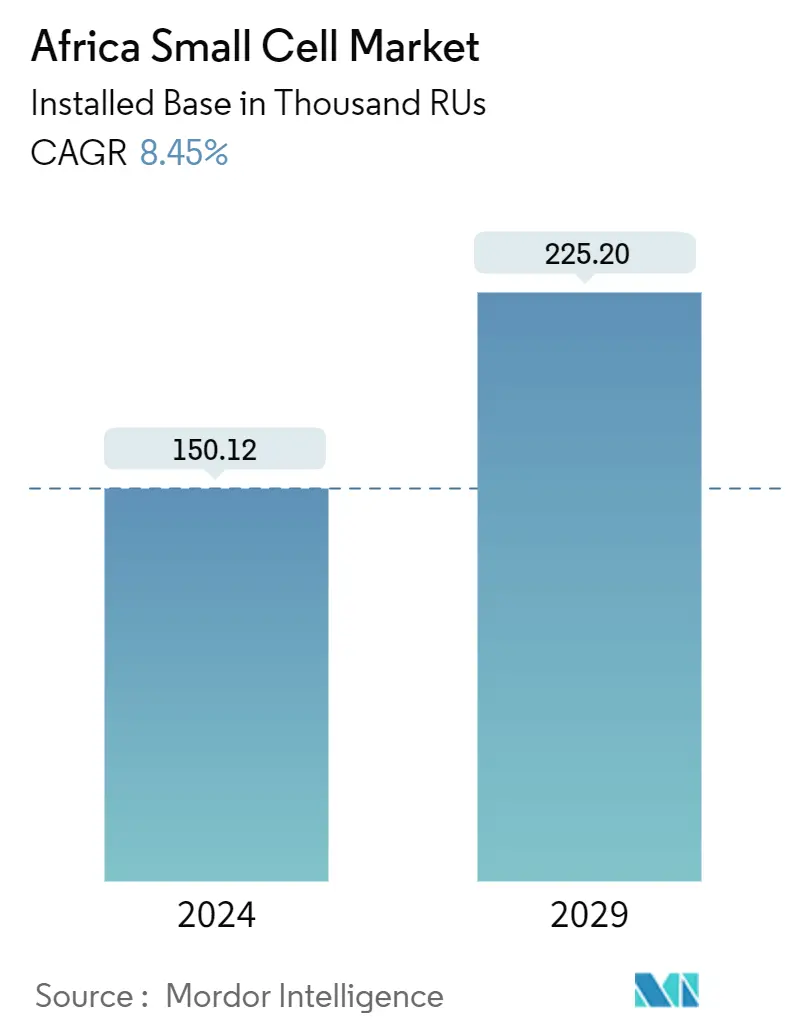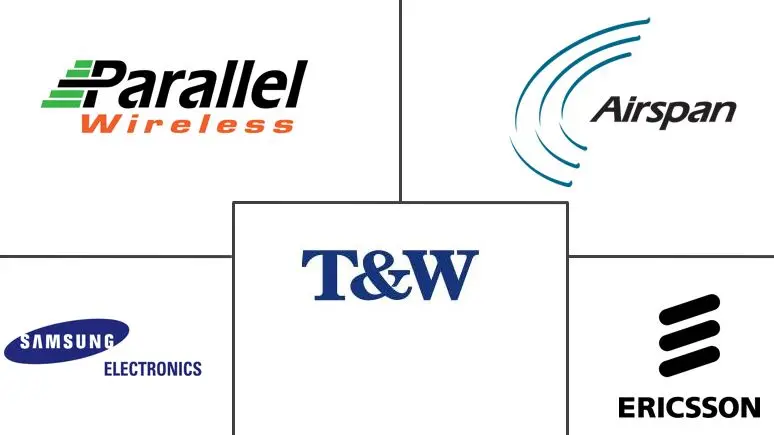Market Size of Africa Small Cell Industry

| Study Period | 2019-2029 |
| Base Year For Estimation | 2023 |
| Forecast Data Period | 2024 - 2029 |
| Historical Data Period | 2019 - 2022 |
| CAGR (2024 - 2029) | 8.45 % |
| Market Concentration | Medium |
Major Players
*Disclaimer: Major Players sorted in no particular order |
Africa Small Cell Market Analysis
The Africa Small Cell Market size in terms of installed base is expected to grow from 150.12 Thousand RUs in 2024 to 225.20 Thousand RUs by 2029, at a CAGR of 8.45% during the forecast period (2024-2029).
Small cells are ideal for utilization where macro-antennas cannot reach them. They also provide a way to rapidly deploy the power of a network with precision and customization for outdoor environments, from sports venues and school campuses to downtown street "canyons" and rural neighborhoods.
- Small cells are projected to make up most of the 5G networks. Small cells are necessary to run 5G networks because they only make the additional data capacity that 5G requires possible. Additionally, by eliminating pricey rooftop systems and installation fees, they aid carriers in cutting expenses. They are also anticipated to aid in improving functionality and battery life.
- Moreover, 5G would be implemented on already-used cellular radio frequencies. Still, it might allow operators to expand and address higher radio frequencies (beyond 20 GHz) to make them functional for mobile services. Moreover, because the signal cannot pass through walls, these frequencies can only be deployed in limited spaces. This encourages tiny cells for in-building applications since they provide superior connectivity for smartphones and Internet of Things (IoT) gadgets.
- The global increase in demand for mobile devices and the advancement of network technology and connected devices are pushing the market. Such demand has been driving the change in the delivery of IT services and has given the market's players a substantial opportunity to strengthen their position there.
- Small cell deployment has introduced new difficulties, such as the backhaul development of small cell networks, even though tiny cells can provide better network coverage at a lower cost.
- The COVID-19 pandemic increased demand for wireless internet as people were restricted to their homes all day (due to lockdowns in many countries) and forced to work from home, connect remotely with their peers, and use the internet services for work and entertainment. This led to a surge in online traffic, which acted as a key factor driving the growth of small cell networks, which are easy to install and cost-effective.
Africa Small Cell Industry Segmentation
Small cell towers are low-power, short-range wireless transmission systems to cover a small geographical area or indoor or outdoor applications. In 5G deployments, small cell towers play a significant role in efficiently providing high-speed mobile broadband and other low-latency applications.
The study analyzes the current deployment scenario of small cell towers in Africa. It provides market forecasts based on the key indicators and deployment plans of the key network providers operating in the region. The study also distinguishes indoor and outdoor-based deployments and tracks key vendor activity and collaborations.
The African small cell market is segmented by application (outdoor, indoor) and by region (North and West Africa, South Africa, and the Rest of Africa). The market sizes and forecasts are provided in terms of value (USD) for all the above segments.
| By Application | |
| Outdoor | |
| Indoor |
| By Region | |
| North & West Africa | |
| South Africa | |
| Rest of Africa |
Africa Small Cell Market Size Summary
The Africa small cell market is poised for significant growth, driven by the increasing demand for mobile connectivity and the advancement of network technologies. Small cells are becoming integral to the deployment of 5G networks, offering a cost-effective solution to enhance network capacity and coverage, particularly in areas where traditional macro-antennas are insufficient. These compact systems are essential for meeting the data demands of 5G, enabling operators to expand their service offerings without the high costs associated with rooftop installations. The market is further bolstered by the rising need for improved connectivity in both urban and rural settings, as well as the growing adoption of Internet of Things (IoT) devices. The COVID-19 pandemic has accelerated this trend, as the surge in online activity highlighted the necessity for robust and easily deployable network solutions.
In Africa, the small cell market is experiencing dynamic growth, supported by strategic partnerships with global technology providers and a focus on expanding mobile network coverage. Companies like Vodafone are pioneering initiatives to enhance rural internet access through open RAN technology trials. The region's market is characterized by fragmentation, with key players such as Samsung Electronics, Parallel Wireless, and Airspan Networks actively engaging in mergers, acquisitions, and product development to strengthen their market presence. The development of private networks using small cells is also a notable trend, providing localized connectivity solutions. As the demand for 5G services continues to rise, small cells are becoming a crucial component in achieving the desired speed, capacity, and low latency, particularly in densely populated urban areas.
Africa Small Cell Market Size - Table of Contents
-
1. MARKET INSIGHTS
-
1.1 Market Overview
-
1.2 Industry Attractiveness - Porter's Five Forces Analysis
-
1.2.1 Bargaining Power of Suppliers
-
1.2.2 Bargaining Power of Consumers
-
1.2.3 Threat of New Entrants
-
1.2.4 Intensity of Competitive Rivalry
-
1.2.5 Threat of Substitute Products
-
-
1.3 Industry Stakeholder Analysis
-
-
2. MARKET SEGMENTATION
-
2.1 By Application
-
2.1.1 Outdoor
-
2.1.2 Indoor
-
-
2.2 By Region
-
2.2.1 North & West Africa
-
2.2.2 South Africa
-
2.2.3 Rest of Africa
-
-
Africa Small Cell Market Size FAQs
How big is the Africa Small Cell Market?
The Africa Small Cell Market size is expected to reach 150.12 thousand RUs in 2024 and grow at a CAGR of 8.45% to reach 225.20 thousand RUs by 2029.
What is the current Africa Small Cell Market size?
In 2024, the Africa Small Cell Market size is expected to reach 150.12 thousand RUs.

